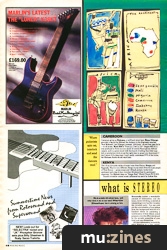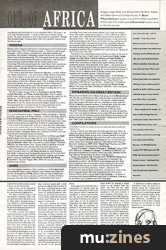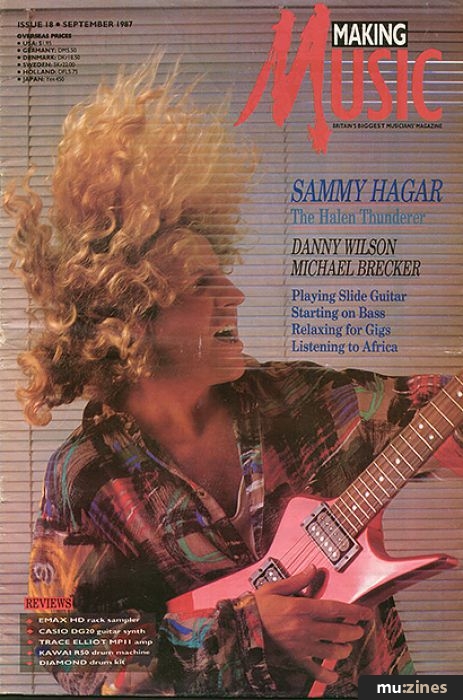Magazine Archive
Home -> Magazines -> Issues -> Articles in this issue -> View
What Is Stereo | |
Article from Making Music, September 1987 | |
Why do we bother with stereo, and what does it do to our ears? Martin Sheehan has it coming at him.

Sounds contain a remarkable amount of information, and the brain, clever old thing, is skilled at interpreting every last bit. Consider the crowded party. You can pick out the conversation of one person from the background hub-bub of a hundred others by analysing a combination of time delays, sound pressure, even the effect introduced by the acoustic properties of your head and ears themselves.
All this information is available when listening to a 'live' sound, but much is lost when the same sound is replayed through loudspeakers. Microphones are not as selective as the ears and brain, and pick up everything within their range with equal impartiality. Hear it back through a loudspeaker and out goes all the directional information that enables our grey matter to focus on the desired part.
Some of this can be restored by recording in stereo, and still more by using binaural reproduction.
The latter involves using a full size model or 'dummy' head, with microphones where the ears would be. This rather amusing set-up is very effective in reproducing directional information, but it requires the use of headphones for playback, rather than loudspeakers.
It works because the dummy head recreates the acoustic baffling effect of a real head. The contours of the head prevent some of the sound which hits one ear from reaching the ear on the other side. The brain then knocks up some quick calculations regarding the differences in the sound at each ear and makes an assumption as to the direction of origin of that sound. Headphones are necessary to ensure that the signals coming from the left and right microphones on each side of the dummy head don't become mixed. Loudspeakers, with their inherent sound spill, would pollute one signal with a section of the other. A binaural set-up is also not compatible with today's penchant for multi-microphone techniques as the 'head' has to hear a sound which is perfectly balanced within itself, without the need to resort to mixers, etc.
The most common for today's sound reproduction is stereo. This is a less precise method of providing directional information than the binaural technique but it has the advantage of being intended for reproduction via loudspeakers, and it is compatible with multi-micro-phone and multitrack recording techniques. Because of the lack of acoustic separation between the two speakers, the positional information on a stereo recording needs to be accentuated. This requirement for a larger-than-life stereo spread is also necessary to overcome the diffusing effect of the imperfect acoustics of any listening room. The stereo spread is produced by the use of the 'pan-pot' on a mixer.
Each signal, be it derived from a microphone or directly from an electronic instrument, is fed via its own pan-pot before it reaches the amplifiers or stereo tape recorder etc. The pan-pot splits the signal and shares it between the left and right sides. It can be rotated to proportion the signal either fully left, fully right or anywhere in between. It will often have a centre detent or click position which identifies the point at which the signal is equally distributed between the left and right channels. This gives the impression that the sound is emanating from a point midway between the two speakers.
As previously mentioned, we judge the direction of a sound source primarily on three things: the time delay between a sound reaching one ear and then the other, the difference in sound pressure between each ear, and the difference in timbre produced by the shape of our ears and head. The pan-pot only imitates the second of these points by making a sound louder in one speaker than the other. (As both left and right halves of the signal are leaving the speakers at the same instant, it can't recreate a time delay.) As a consequence of this, high frequency sounds are panned more effectively than low frequency ones. For instance, the sound of a hi-hat merrily ticking away will appear to move smoothly from left to right as the pan-pot is rotated clockwise. The sound of a mellow bass guitar, however, will seem to jump from the left speaker, into the centre, and then leap off again into the right hand speaker when the same manoeuvres are performed. The reason for this is that the ear is better at accepting sound pressure level (volume) as a directional clue for high frequency sounds (above about 1kHz) than it is with low frequencies. Low frequency directional information is more reliant on the time delay factor — an element not catered for by the pan-pot.
A definition of stereo might be something along the lines of: a system using two independent channels of sound in order to create the illusion of a soundscape spread across the horizontal plane. Note, however, the word "illusion" in this definition. Considering the complexity of the human hearing process, isn't it odd that we allow ourselves to be tricked by such simple means?
More with this topic
Sonics & Harmonics |
Looking at Microphones |
Bits 'n' Pieces - An Introduction to Digital Audio (Part 1) |
Anatomy Of A Studio - The Mixer (Part 1) |
The Rough Guide To Choosing Microphones |
Tape Line-Up (Part 1) |
Great Audio Concepts (Part 1) |
How It Works - Tape Machines (Part 1) |
dB or not dB - — Dat is de Question |
Ears |
Sound Systems For Synthesizers |
When Is A Room - Sound Training |
Browse by Topic:
Sound Fundamentals
Publisher: Making Music - Track Record Publishing Ltd, Nexus Media Ltd.
The current copyright owner/s of this content may differ from the originally published copyright notice.
More details on copyright ownership...
Feature by Martin Sheehan
Help Support The Things You Love
mu:zines is the result of thousands of hours of effort, and will require many thousands more going forward to reach our goals of getting all this content online.
If you value this resource, you can support this project - it really helps!
Donations for May 2024
Issues donated this month: 0
New issues that have been donated or scanned for us this month.
Funds donated this month: £0.00
All donations and support are gratefully appreciated - thank you.
Magazines Needed - Can You Help?
Do you have any of these magazine issues?
If so, and you can donate, lend or scan them to help complete our archive, please get in touch via the Contribute page - thanks!
















